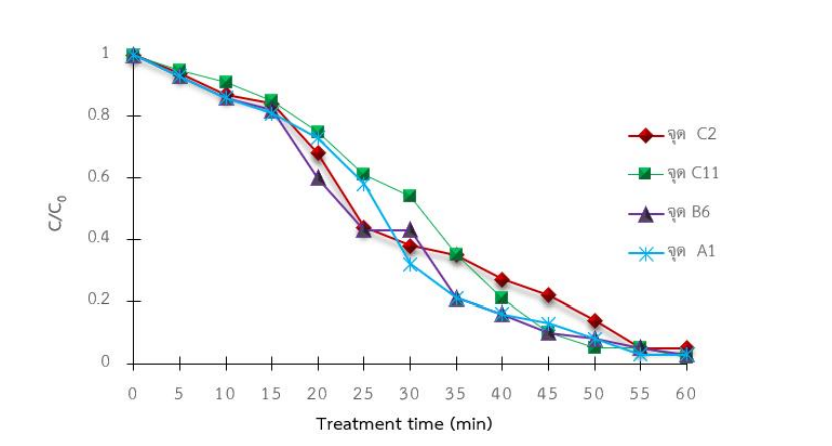Formaldehyde treatment with ozone in anatomy classroom
Main Article Content
Abstract
The teaching and learning of professors, students, and staff working at anatomy buildings are often affected by the odor of formaldehyde gas emitted from the dissection of the cadaver during the study. For this reason, ozone was used for classroom formaldehyde gas treatment. This study aims to study the appropriate conditions and the effectiveness of ozone in the treatment of formaldehyde gas in a classroom at the anatomy building of one university. The instruments included the reactor, portable formaldehyde monitor, HFX 205 model, and Hotwire Anemometer. Area sampling was performed as a baseline before treatment. It uses oxygen to produce ozone from pure oxygen cylinders. Measurements and treatment were performed on the day of the corpse's body opening. The results showed that the optimum conditions for the treatment of formaldehyde gas in the classroom with ozone were the ozone spray rate of 1,100 mg / hr at a fan speed of 1.80 m/s with a suction radius of 7 m. The appropriate suction rate is 0.608 m3 /s. It takes at least 25 minutes to bring the concentration below the standard, with the highest treatment efficiency of 89.8%.
Article Details
เนื้อหาและข่อมูลในบทความที่ลงตีพิมพ์ในวารสารวิชาการ เทคโนโลยี พลังงาน และสิ่งแวดล้อม บัณฑิตวิทยาลัย วิทยาลัยเทคโนโลยีสยาม ถือเป็นข้อคิดเห็นและความรับผิดชอบของผู้เขียนบทความโดยตรง ซึ่งกองบรรณาธิการวารสารไม่จำเป็นต้องเห็นด้วย หรือว่าร่วมรับผิดชอบใด ๆ
บทความ ข้อมูล เนื้อหา รูปภาพ ฯลฯ ที่ได้รับการตีพิมพ์ในวารสารวิชาการ เทคโนโลยี พลังงาน และสิ่งแวดล้อม บัณฑิตวิทยาลัย วิทยาลัยเทคโนโลยีสยาม ถือเป็นลิขสิทธิ์ของวารสารวิชาการ เทคโนโลยี พลังงาน และสิ่งแวดล้อม บัณฑิตวิทยาลัย วิทยาลัยเทคโนโลยีสยาม หากบุคคล หรือหน่วยงานใดต้องการนำทั้งหมด หรือส่วนหนึ่งส่วนใดไปเผยแพร่ต่อ หรือเพื่อกระทำการใด ๆ จะต้องได้รับอนุญาต เป็นลายลักษณ์อักษรจากวารสารวิชาการ เทคโนโลยี พลังงาน และสิ่งแวดล้อม บัณฑิตวิทยาลัย วิทยาลัยเทคโนโลยีสยาม เท่านั้น
References
สุรินทร์ อยู่ยง. ฟอร์มาลิน-ฟอร์มัลดีไฮด์ [อินเตอร์เน็ต]. 2559. [เข้าถึงเมื่อ 10 เมษายน 2563]. เข้าถึง ได้ จาก : URL; https://www.pharmacy.mahidol.ac.th/th/knowledge/article/32
วิภาดา เดชะปัญญา และสรรพาวุธ นนท์ตุลา. การบำบัดก๊าซฟอร์มัลดีไฮด์ในห้องจำลองระบบปิดที่มีแหล่งกำเนิดอย่างต่อเนื่องด้วยโอโซน. วารสารวิศวกรรมสิ่งแวดล้อมไทย 2560; 31(1): 37-43
บังอร ฉางทรัพย์. ฟอร์มาลดีไฮด์ / ฟอร์มาลีน ภัยร้ายใกล้ตัว. วารสารวิทยาศาสตร์และเทคโนโลยี
หัวเฉียวเฉลิมพระเกียรติ 2558; 1(1): 97-109
ขจร ลักษณ์ชยปกรณ์ และเพ็ญศรี วัจฉละญาณ. การได้รับฟอร์มาลดีไฮด์ของนักศึกษาแพทย์และ
อาจารย์และอาการทางคลินิกในห้องปฏิบัติการกายวิภาคมหาวิทยาลัยธรรมศาสตร์. วารสารสมาคมแพทย์แห่งประเทศไทย 2553; 93(7): 92-98
สงกรานต์ ปัณะกา. 2561. การประเมินความเสี่ยงต่อการเกิดมะเร็งและความเสี่ยงทางด้านสุขภาพจากการรับสัมผัสฟอร์มัลดีไฮด์ของอาจารย์ นักศึกษาแพทยศาสตร์ และเจ้าหน้าที่ในห้องปฏิบัติการมหกายวิภาคศาสตร์ มหาวิทยาลัยอุบลราชธานี. ปัญหาพิเศษ.
The National Institute for Occupational Safety and Health (NIOSH). (2016). NIOSH
Pocket Guide to Chemical Hazards. Retrieved April 5, 2021, from https://www.cdc.gov/niosh /npg/ default.html
ทัดดาว พาหาทรัพย์อนันต์ ซูรัยนี เจ๊ะสือแม ซูราญา สาแม ซัลวานา ยูโซ๊ะ อิลฮัม บินดาแม. การประเมินความเสี่ยงจากการสัมผัสสารฟอร์มัลดีไฮด์ในห้องปฏิบัติการกายวิภาคศาสตร์ของมหาวิทยาลัยแห่งหนึ่ง J of Energy and Env Tech; 7(1): 61-68.
Jerrett M, Burnett RT, Pope CA, 3rd, et al. Long-term ozone exposure and mortality. NEngl J Med 2009; 360(11): 1085-95.
Horvath, M., Bilitzky, L. and Huttner, J.1985. Ozone. Budapest: Elsevier
กมลวรรณ พรมเทศ, อรวรรณ แก้วบุญชู, กิติพงษ์ หาญเจริญ และ ฉัตรชัย เอกปัญญาสกุล. การประเมินความเสี่ยงต่อการเกิดมะเร็งของการรับสัมผัสฟอร์มัลดีไฮด์ทางการหายใจในนิสิตแพทย์ระหว่างเรียนภาคปฏิบัติทางกายวิภาค. วารสารพิษวิทยาไทย 2557; 29(1-2): 8-22
ศิริพร วันฟั่น. รู้จักฟอร์มัลดีไฮด์ สารอันตรายใกล้ตัว [อินเตอร์เน็ต]. 2556. [เข้าถึงเมื่อ 30 เมษายน 2563] เข้าถึงได้ จาก URL; http://www.thailandindustry.com/indust_newweb/ articles_ preview.php?cid=19310


